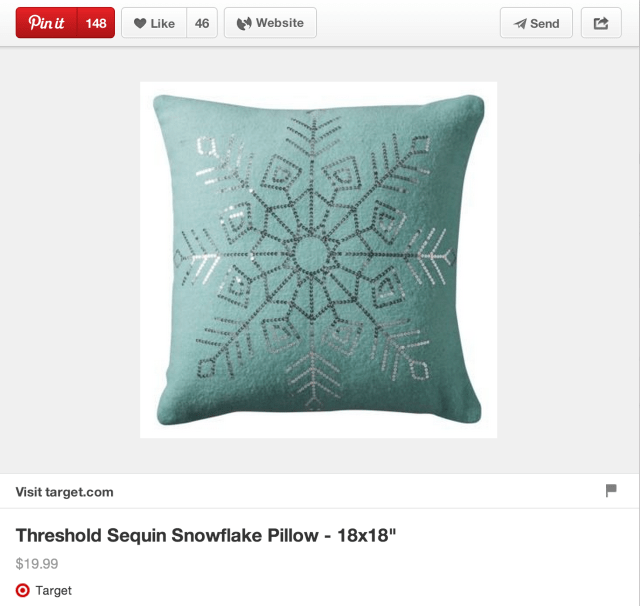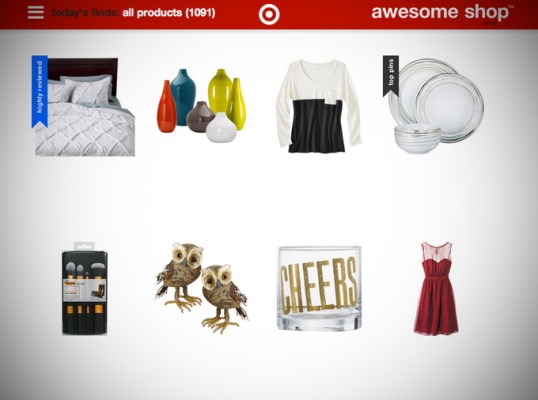Target is testing an e-commerce storefront powered entirely by Pinterest recommendations, with the beta launch of a site called “Target Awesome Shop.” The site, refreshed daily, is a mashup of data from Target’s own online store and the social network. Today, it features Target products that have proven to be the most pinned items on Pinterest and have the top reviews from Target.com. The new shop may grow to include other social networks in the future, the company says.
The Awesome Shop website was hacked together in just a couple of weeks by an in-house development team called the RAD (Rapid Accelerated Development) group – a small team who can quickly build, deploy and test new initiatives like this socially powered shopping experience.
The retailer has already embraced the Pinterest platform itself, maintaining 45 regularly updated boards featuring everything from general product categories (Home, Style, Food & Drink, etc.) to those specially aimed at the Pinterest crowd in search of tips, ideas, and how-to’s. There are several seasonal boards, too, promoting holiday items and activities, as well as a “Pins You Love” board which already aggregated the top pinned items.
Asked what the benefit of sending pinners away from Pinterst to a standalone site were, Target communications manager Eddie Baeb explained the idea was to design a curated experience that also included the data from trending products (4 stars or higher) on Target.com. That’s something a third-party site like Pinterest wouldn’t have access to, so it’s telling that Target is testing this particular data set off of Pinterest, rather than within yet another Pinterest board.

Currently, the new website is hosting over 1,000 items, some of which are flagged as “top pinned” or “highly reviewed.”
The company declined to offer details on the traffic and conversions Pinterest provides Target.com with overall, but the company previously reported a 70 percent increase in traffic in the first six weeks following the rollout of Pinterest’s “Rich Pins” earlier this year.
Generally speaking, third-party analysis of Pinterest activity has found the value of a pin steadily increasing. Today, a pin on Pinterest is worth 25 percent more in sales than a year ago, one report recently found, for example. And that revenue skyrocketed during the Black Friday/Cyber Monday shopping holidays this year, benefitting retailers who already had established a presence on the site with as much as three times the usual sales revenue.
Some retailers, like Nordstrom, have gone even further with their Pinterest activity. At that store, tests have been underway involving sales staff who carry around iPads showing trending pins, as well as in-store merchandise flagged as being popular on Pinterest.
The moves come at a time when Pinterest itself is working to implement its own advertising model, which would see retailers paying for prime spots in search results and category feeds.
As for Target, the retailer says that it will be watching to see how its customers react to the new “Awesome Shop” to determine how the service could fit in with the company’s future plans, as well as what features the site may receive next. Potentially, it could become a Target.com feature, perhaps similar to how ToyRUs.com now highlights top-pinned items within its own site.
A Need To Drive More Online Sales
But what’s also notable about the new Pinterest-powered Target shop is how quickly it was built. With Amazon’s ever-growing online footprint, major brick-and-mortar retailers like Target and Walmart have had to increase their own pace of technological innovation in-house for themselves.
 In Walmart’s case, the company runs an R&D lab in Silicon Valley called @Walmart Labs which has acquired a range of startups testing new ideas in e-commerce, ranging from cloud computing services, website optimizers, development shops, analytics providers and more. Some of these have gone on to power Walmart.com features, like Kosmix did by improving the site’s search engine, while others have been experiments that later folded.
In Walmart’s case, the company runs an R&D lab in Silicon Valley called @Walmart Labs which has acquired a range of startups testing new ideas in e-commerce, ranging from cloud computing services, website optimizers, development shops, analytics providers and more. Some of these have gone on to power Walmart.com features, like Kosmix did by improving the site’s search engine, while others have been experiments that later folded.
Target, meanwhile, is in perhaps greater need to catch up – the company has seen declining sales recently, only a small amount of which are online. (Just 2 percent of its $73 billion in total sales in 2012, The WSJ recently noted.) The company brought its e-commerce site’s management in-house in 2011. Before that, it had outsourced its operations to Amazon, a potentially critical mistake. Even afterwards, the company hasn’t always prioritized the online shopping angle, having focused more on things that get people to shop in stores, like renovations, adding additional employees to help customers, and increasing selection of fresh foods, for example.
However, the Minneapolis-based retailer has made some progress on the social front in the recent past, with Facebook integrated deals. It also has other digital initiatives underway, like its well-received mobile offers app Cartwheel, the opening of R&D labs in the Valley and elsewhere, the launch of its own video download and rental service, Target Ticket, and more.
Whether the Pinterest-powered “Awesome Shop” ever translates to something that fares well enough to be integrated into Target’s online or mobile sites in order to beef up e-commerce sales remains to be seen, though. In the meantime, it remains more of a one-off experiment to see to what extent the Pinterest effect translates when a customer leaves Pinterest.com.
